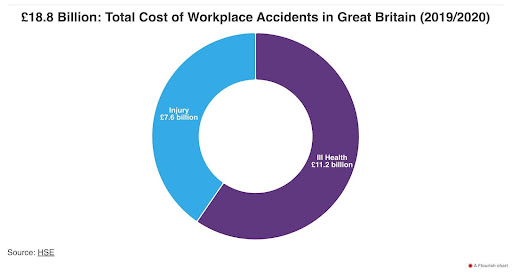The importance of managing health and safety at work is multi-faceted. It’s about human lives, ethical responsibility, economic implications and societal stability. Let’s explore these figures and their implications further to understand the true gravity of the situation and what it means for industries across Great Britain.
The issue of workplace health and safety isn’t just a matter of legal compliance; it’s a real concern affecting lives every day. And, in Great Britain, the 2022/23 period has highlighted a critical need for renewed focus on managing health and safety in the workplace.
Figures from the Health and Safety Executive (HSE) show that 135 workers tragically lost their lives due to work-related incidents in 2023. This marks a 10% increase from the previous year, underscoring the necessity of revisiting safety protocols and heightening awareness.

Source: HSE
When we hear statistics, it’s easy to forget that behind every number is an individual, a family and a story. For instance, while the HSE reports that the number of deaths involving the public (68) decreased by 20 incidents from last year, every fatal accident in the workplace is a tragedy. These figures are more than mere statistics — they’re a call to action for employers across the country to be proactive at managing health and safety at work.
Here’s why it’s a call you should take seriously.
Every Employer Is Bound By Law To Manage Health And Safety At Work
The United Kingdom’s commitment to ensuring the health and safety of its workforce is enshrined in the Health and Safety at Work Act 1974. This pioneering legislation serves as a foundation for the safe operations of businesses across sectors, ensuring employers take necessary precautions to protect their employees from harm. It mandates that employers ensure, so far as is reasonably practicable, the health, safety and welfare of all their employees.
Related Reading: What Is The Health And Safety At Work Act? Everything You Need To Know
The Act also created the Health and Safety Executive (HSE), the national regulator for occupational health and safety. The HSE not only sets the standards for managing health and safety in the workplace but also monitors and enforces the law. It provides guidance, conducts inspections, and takes enforcement actions against businesses that are found in violation of the Act. Penalties can range from improvement notices to substantial fines, depending on the severity and nature of the breach. In extreme cases, businesses can even face legal action, leading to criminal charges, a significant blot on a company’s reputation
Free Risk Assessment Template
Take the stress and confusion out of creating a risk assessment with our free template.
Enter your details, and we’ll email you a risk assessment template that’s both compliant and comprehensive to use.
By submitting this form you confirm you are happy to be contacted by CHAS in accordance with our Privacy Policy
Meanwhile, the Management of Health and Safety at Work Regulations 1999 builds on the requirements set by the Health and Safety at Work Act and sets the overall framework for a safe system of work, including identifying and minimising potential risks through proper risk assessments.
Related Reading: What Is The Purpose Of Risk Assessments?
Benefits Of Managing Health And Safety For UK Employers
The HSE reports that the total cost of work-related injuries and ill health in 2019/2020 was £18.8 billion. Incidents of ill health represented the larger proportion (60%) of total costs at around (£11.2 billion); meanwhile, injuries at work account for 40% of total costs — equivalent to £7.6 billion.

In other words, managing workplace health and safety isn’t merely about compliance, but it also offers both tangible and intangible benefits that can significantly impact your organisation’s bottom line and reputation.
- Boost in productivity: Employees working in a safe and secure environment are more likely to be engaged and motivated. This often translates to increased efficiency, reduced mistakes and a higher quality of work. By mitigating risks and eliminating hazards, businesses can ensure smoother operations with fewer disruptions.
- Reduced absenteeism: Workplace accidents and ill-health can lead to significant absenteeism. Investing in proactive health and safety measures reduces the likelihood of such incidents, ensuring that the workforce remains healthy and active, leading to consistent operational flow.
- Insurance and liability: A robust health and safety record can result in reduced insurance premiums. Many insurance providers offer discounts or favourable terms to businesses that demonstrate a commitment to maintaining safe workplaces. Additionally, a reduction in accidents means fewer compensation claims, protecting the company’s finances.
- Reputation enhancement: In an age of information, companies’ health and safety records are easily accessible. A stellar record can be a strong selling point, making businesses more attractive to potential clients, customers and even future employees. In contrast, any mishap can cause significant reputational damage, making proactive safety measures even more crucial.
Benefits Of Managing Health And Safety For Employees
Whilst employers shoulder much of the responsibility of managing health and safety in the workplace, employees also play a key role in maintaining a positive safety culture — and for good reason. A safe workplace benefits workers and the general public.
- Physical protection: The primary objective of health and safety measures is to protect employees from harm. In 2021/2022, there were 1.8 million work-related ill health cases (new or long-standing). Adhering to and continuously improving upon health and safety standards goes a long way towards reducing this number, ensuring fewer individuals suffer the consequences of workplace hazards.
- Peace of mind: When employers prioritise health and safety, employees experience increased wellbeing. A study revealed that 86% of workers would be more likely to leave their jobs if their employers did not support their wellbeing.
- Financial security: Workplace accidents have financial implications for employees. In fact, HSE reports that individuals bear the majority of costs associated with workplace injuries and ill health. Creating safer workplaces will help employees avoid these unexpected costs.

Managing health and safety at work offers indispensable benefits both for employers and employees. While businesses see tangible returns in productivity, reduced absenteeism and a bolstered reputation, employees benefit from physical protection, mental peace and financial security.
A commitment to safety can significantly reduce the tens of thousands of reported non-fatal injuries annually. Moreover, a safe environment is influential in job satisfaction and retention, with a vast majority of workers seeing it as a deciding factor in job continuation. The intertwined advantages of safety measures highlight the need for a joint employer-employee effort towards a safer work culture.
If you own or manage a business and want to demonstrate your compliance with health and safety legislation, become an accredited CHAS member today. Get started with CHAS Standard and get preferred access to our growing network of 2,500+ CHAS Clients across the UK.
Book a callback to learn more about our compliance and supply chain risk management services.
Request A Callback
By submitting this form you confirm you are happy to be contacted by CHAS in accordance with our Privacy Policy.



